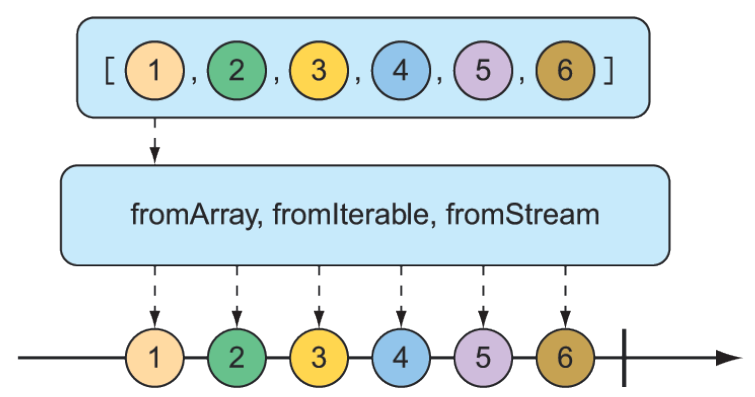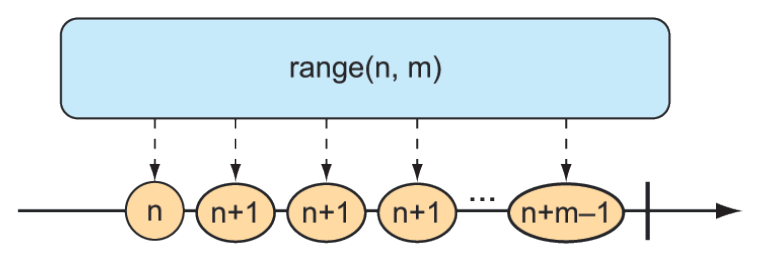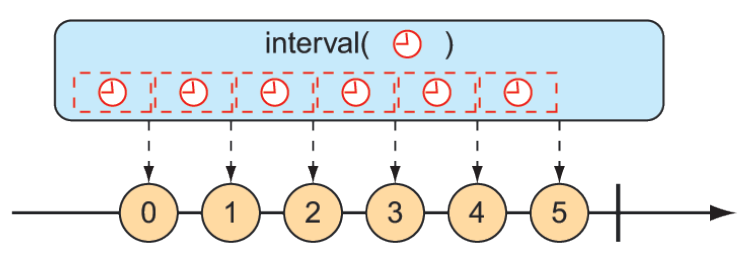11.3.1 Creating reactive types
Often when working with reactive types in Spring, you’ll be given a Flux or a Mono from a repository or a service, so you won’t need to create one yourself. But occasionally you’ll need to create a new reactive publisher.
Reactor provides several operations for creating a Flux or Mono. In this section, we’ll look at a few of the most useful creation operations.
CREATING FROM OBJECTS
If you have one or more objects from which you’d like to create a Flux or Mono, you can use the static just() method on Flux or Mono to create a reactive type whose data is driven by those objects. For example, the following test method creates a Flux from five String objects:
@Test
public void createAFlux_just() {
Flux<String> fruitFlux = Flux
.just("Apple", "Orange", "Grape", "Banana", "Strawberry");
}At this point, the Flux has been created, but it has no subscribers. Without any subscribers, data won’t flow. Thinking of the garden hose analogy, you’ve attached the garden hose to the spigot, and there’s water from the utility company on the other side—but until you turn on the spigot, water won’t flow. Subscribing to a reactive type is how you turn on the flow of data.
To add a subscriber, you can call the subscribe() method on the Flux as follows:
fruitFlux.subscribe(
f -> System.out.println("Here's some fruit: " + f);
);The lambda given to subscribe() here is actually a java.util.Consumer that’s used to create a Reactive Streams Subscriber. Upon calling subscribe(), the data starts flowing. In this example, there are no intermediate operations, so the data flows directly from the Flux to the Subscriber.
Printing the entries from a Flux or Mono to the console is a good way to see the reactive type in action. But a better way to actually test a Flux or a Mono is to use Reactor’s StepVerifier. Given a Flux or Mono, StepVerifier subscribes to the reactive type and then applies assertions against the data as it flows through the stream, finally verifying that the stream completes as expected.
For example, to verify that the prescribed data flows through the fruitFlux, you can write a test that looks like this:
StepVerifier.create(fruitFlux)
.expectNext("Apple")
.expectNext("Orange")
.expectNext("Grape")
.expectNext("Banana")
.expectNext("Strawberry")
.verifyComplete();In this case, StepVerifier subscribes to the Flux and then asserts that each item matches the expected fruit name. Finally, it verifies that after Strawberry is produced by the Flux, the Flux is complete.
For the remainder of the examples in this chapter, you’ll use StepVerifier to write learning tests—tests that verify behavior and help you understand how something works—to get to know some of Reactor’s most useful operations.
CREATING FROM COLLECTIONS
A Flux can also be created from an array, Iterable, or Java Stream. Figure 11.3 illustrates how this works with a marble diagram.
 Figure 11.3 A Flux can be created from an array, Iterable, or Stream.
Figure 11.3 A Flux can be created from an array, Iterable, or Stream.
To create a Flux from an array, call the static fromArray() method, passing in the source array like so:
@Test
public void createAFlux_fromArray() {
String[] fruits = new String[] {
"Apple", "Orange", "Grape", "Banana", "Strawberry" };
Flux<String> fruitFlux = Flux.fromArray(fruits);
StepVerifier.create(fruitFlux)
.expectNext("Apple")
.expectNext("Orange")
.expectNext("Grape")
.expectNext("Banana")
.expectNext("Strawberry")
.verifyComplete();
}Because the source array contains the same fruit names you used when creating a Flux from a list of objects, the data emitted by the Flux will have the same values. Thus, you can use the same StepVerifier as before to verify this Flux.
If you need to create a Flux from a java.util.List, java.util.Set, or any other implementation of java.lang.Iterable, you can pass it into the static fromIterable() method, as shown here:
@Test
public void createAFlux_fromIterable() {
List<String> fruitList = new ArrayList<>();
fruitList.add("Apple");
fruitList.add("Orange");
fruitList.add("Grape");
fruitList.add("Banana");
fruitList.add("Strawberry");
Flux<String> fruitFlux = Flux.fromIterable(fruitList);
StepVerifier.create(fruitFlux)
.expectNext("Apple")
.expectNext("Orange")
.expectNext("Grape")
.expectNext("Banana")
.expectNext("Strawberry")
.verifyComplete();
}Or, if you happen to have a Java Stream that you’d like to use as the source for a Flux, fromStream() is the method you’ll use, as shown next:
@Test
public void createAFlux_fromStream() {
Stream<String> fruitStream =
Stream.of("Apple", "Orange", "Grape", "Banana", "Strawberry");
Flux<String> fruitFlux = Flux.fromStream(fruitStream);
StepVerifier.create(fruitFlux)
.expectNext("Apple")
.expectNext("Orange")
.expectNext("Grape")
.expectNext("Banana")
.expectNext("Strawberry")
.verifyComplete();
}Again, you can use the same StepVerifier as before to verify the data published by the Flux.
GENERATING FLUX DATA
Sometimes you don’t have any data to work with and just need Flux to act as a counter, emitting a number that increments with each new value. To create a counter Flux, you can use the static range() method. The diagram in figure 11.4 illustrates how range() works.
 Figure 11.4 Creating a Flux from a range results in a counter-style publishing of messages.
Figure 11.4 Creating a Flux from a range results in a counter-style publishing of messages.
The following test method demonstrates how to create a range Flux:
@Test
public void createAFlux_range() {
Flux<Integer> intervalFlux =
Flux.range(1, 5);
StepVerifier.create(intervalFlux)
.expectNext(1)
.expectNext(2)
.expectNext(3)
.expectNext(4)
.expectNext(5)
.verifyComplete();
}In this example, the range Flux is created with a starting value of 1 and an ending value of 5. The StepVerifier proves that it will publish five items, which are the integers 1 through 5.
Another Flux-creation method that’s similar to range() is interval(). Like the range() method, interval() creates a Flux that emits an incrementing value. But what makes interval() special is that instead of you giving it a starting and ending value, you specify a duration or how often a value should be emitted. Figure 11.5 shows a marble diagram for the interval() creation method.
 Figure 11.5 A Flux created from an interval has a periodic entry published to it.
Figure 11.5 A Flux created from an interval has a periodic entry published to it.
For example, to create an interval Flux that emits a value every second, you can use the static interval() method as follows:
@Test
public void createAFlux_interval() {
Flux<Long> intervalFlux =
Flux.interval(Duration.ofSeconds(1))
.take(5);
StepVerifier.create(intervalFlux)
.expectNext(0L)
.expectNext(1L)
.expectNext(2L)
.expectNext(3L)
.expectNext(4L)
.verifyComplete();
}Notice that the value emitted by an interval Flux starts with 0 and increments on each successive item. Also, because interval() isn’t given a maximum value, it will potentially run forever. Therefore, you also use the take() operation to limit the results to the first five entries. We’ll talk more about the take() operation in the next section.
